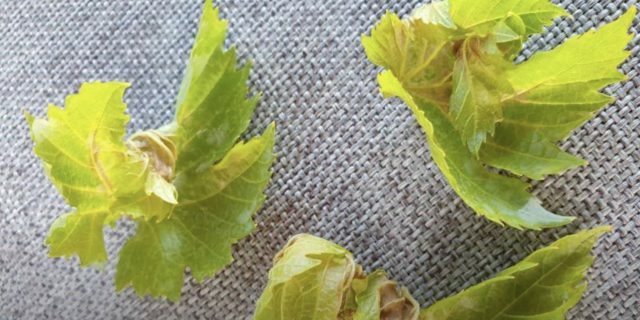How to plant grapes and care for them so that the harvest pleases
Miscellaneous / / April 04, 2023
We understand all the intricacies: from choosing a seedling to sheltering plants for the winter.
When to plant grapes
In the spring, wait until the soil warms up to 10 degrees, and the air temperature reaches 15 degrees during the day and does not fall below 5 at night. In most regions, such conditions develop around the second half of April. You can plant grapes until the beginning of June.
In autumn, also pay attention to the weather forecast. The temperature during the day should not rise above 15 degrees, and at night - fall below 5 degrees. It is also important to cope before the arrival of the first serious frosts. On average, the autumn planting season lasts from late September to late October, but it is better to check the climatic features of your region.
How to choose a grape seedling
In spring and autumn, you can plant grapes grown from cuttings. How to do it correctly, we described in detail in this article.
For ready-made seedlings, go to a garden center or nursery - this way you will be sure that the grapes correspond to the declared variety. The roots of a healthy seedling are white, well developed, and their diameter is at least 2 mm.
If the grapes have leaves, make sure they are a uniform green color. You should not take a seedling with deformed, spotty, dry and bumpy foliage.

1 / 0
The leaves of a healthy seedling are green and evenly colored. Frame: Grozdi Grape / YouTube

2 / 0
Do not take a seedling with deformed, dry and spotted leaves. Frame: Grozdi Grape / YouTube
Pay attention to the trunk. It should be covered with dense, matured wood, free of cracks, damage, swollen areas and mold. Such imperfections can be signs of disease.
Sleeping buds on the stems of a healthy seedling are elastic and hard. If they are dry and fall off with light pressure, do not take such grapes.
How to prepare a site for planting grapes
Pay attention to this stage, the normal development of plants depends on it.
Decide on a site
Find a sunny place where water does not stagnate after rains and snow melt. If you plant grapes near buildings or a fence, try to keep a distance of at least 1 m. Also, do not place plants in lowlands, because there they will be susceptible to frost.
Make a landing hole
Its depth, width and diameter should be equal to 60 cm. If you plant several bushes, keep a distance of 1.5–3 m between them.
At the bottom of the landing pit, pour a drainage layer of 10 cm: sand, broken brick, expanded clay or fine gravel will do.
On top, add 2-3 liters of compost and 2 liters of wood ash, as well as 200 g of superphosphate and 100 g of urea. Pour 10 liters of peat in another layer, and then mix all the ingredients.
How to plant grapes
Carefully remove the seedling from the seedling pot, being careful not to damage the roots. Place it at the bottom of the planting hole.
Fill all voids around the seedling with soil. It is not necessary to fill the hole flush with the ground, leave a small depression of 5–10 cm for subsequent watering.
Pour 20 liters of water under the grape root. Wait until it is completely absorbed.
Set the support peg 5 cm from the stem of the seedling. You can use a wooden stick or a piece of plastic pipe. Tie the stem of the grape to the support so that the knot is loose.
Fill the near-stem circle around the vine stem with soil so that it is flush with the surface of the bed.
Mulch the trunk circle with hardwood sawdust. Mulch will retain moisture in the soil longer. A layer of 5-10 cm is enough. Don't use sawdust or spruce needles, which make the soil too acidic for grapes.
How to care for grapes
To get a good harvest, you have to work hard.
Water the grapes
In the first year after planting, the plants are watered weekly at 10-20 liters per bush - so that the soil is moist all the time. The next year, start caring for the grapes like adults.
Adult grapes can easily tolerate drought, so they water it rarely, but plentifully. In the spring, when the bushes begin to grow and begin to release leaves, you can begin to moisten the soil if there was no rain. Watered about once every 1-2 weeks, one plant needs a lot of water - about 40-60 liters.
Approximately 2 weeks before the start of flowering (approximately in mid-May), stop watering the grapes until the ovaries appear. In late summer - early autumn, the berries will begin to ripen, pour and color. As soon as you notice these changes, also stop watering the bushes, otherwise the berries may crack from excess moisture.
The next time the plants are watered after the leaves fall. At this time, you need to thoroughly moisten the soil, which will save the roots of the grapes from freezing in winter. Pour 80–100 liters of water under each bush and forget about this procedure until spring.
Feed the grapes
In the first year, the bushes do not need fertilizers, because all the necessary substances were introduced into the planting pit. Grapes aged 1 year and older are fed 3 times per season. It is better to do this early in the morning or in the evening at sunset, so as not to provoke sunburn of the plants.
- In early spring, when the buds on the vine begin to swell, dilute 60 g of superphosphate, 30 g of potassium sulfate and 90 g of urea in 40 liters of water. Pour the mixture under the roots of the plants. This volume is enough for 1 m2 vineyard.
- Spend the second dressing when the grapes have released buds, but have not yet bloomed. In 40 liters of water, dilute 160 g of superphosphate, 120 g of ammonium nitrate and 80 g of potassium sulfate, and then pour the grapes under the root. The solution is enough for 1 m2 earth.
- When the berries become large and just begin to ripen, take 60 g of superphosphate and 30 g of potassium sulfate per 40 liters of water. This is enough for 1 m2 landings. Pour the solution under the root of the grapes.
Cover grapes for the winter
The procedure is usually started in November or even in December, when stable frosts from -5 to -8 degrees are established, but not lower than -10. Covering grapes in warmer weather is not worth it: the vine must freeze and harden in order to better survive the winter.
On the ground in the vineyard, lay small wooden blocks in increments of 0.5-1 m and lay the vine on them. So the branches will not come into contact with the ground and will not freeze or begin to warm up if a thaw occurs. For reliability, you can fix the vine with metal rods that are inserted into the ground like hairpins.
Synthetic batting, large bags that sell sugar, or even polyethylene foam underlays (it can still often be found in boxes with new household appliances). Lay the shelter on the vine in one, and preferably in two layers. Attach the edges to the ground with metal studs, bricks or heavy stones so that it is not blown away by the wind.
In the spring, when the snow melts, remove the shelter. At the same time, daytime temperatures should be consistently positive, and at night they should not fall below -4 degrees.
Read also🧐
- How to prune gooseberries
- How to plant a tree
- How to care for strawberries so that there are a lot of berries
- When and how to plant currants, then to collect large berries
- How to carry out the autumn processing of the garden from diseases and pests
Best deals of the week: discounts from AliExpress, Befree, Henderson and other stores



